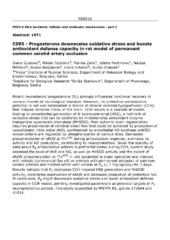Приказ основних података о документу
Progesterone downscales oxidative stress and boosts antioxidant defense capacity in rat model of permanent common carotid artery occlusion
| dc.creator | Guševac, Ivana | |
| dc.creator | Tatalović, Nikola | |
| dc.creator | Zarić, Marina | |
| dc.creator | Martinović, Jelena | |
| dc.creator | Mitrović, Nataša | |
| dc.creator | Blagojević, Duško | |
| dc.creator | Grković, Ivana | |
| dc.creator | Drakulić, Dunja | |
| dc.date.accessioned | 2020-09-29T08:13:36Z | |
| dc.date.available | 2020-09-29T08:13:36Z | |
| dc.date.issued | 2018 | |
| dc.identifier.uri | https://forum2018.fens.org/ | |
| dc.identifier.uri | https://radar.ibiss.bg.ac.rs/123456789/3897 | |
| dc.description.abstract | Potent neurosteroid progesterone (P4) strongly influences functional recovery in various models of neurological diseases. However, its protective antioxidative potential is not well established in stance of chronic cerebral hypoperfusion (CCH) that induces ischemic milieu in the brain. CCH results in a cascade of events leading to uncontrolled generation of 4-hydroxynonenal (HNE), a hallmark of oxidative stress that can be abolished by mitochondrial antioxidant enzyme manganese superoxide dismutase (MnSOD). Post-ischemic brain regeneration requires preservation of cerebral blood flow that could be achieved by production of vasodilatator nitric oxide (NO), synthesized by endothelial NO synthase (eNOS) whose actions are regulated by phosphorylation at various sites. Decreased phosphorylation of eNOS at Thr495 during antioxidative response, promotes its activity and NO production, contributing to neuroprotection. Given the scarcity of data about P4 antioxidative actions in prefrontal cortex during CCH, current study assessed the level of HNE and NO, as well as MnSOD activity and the extent of eNOS phosphorylation at Thr495 in rats subjected to sham operation and injected with vehicle (commercial flax oil) or animals with permanent occlusion of common carotid arteries and treated either with vehicle or P4 (1.7 mg/kg/day) for 7 days. Results indicate that P4 decreases CCH-induced HNE generation and MnSOD activity, diminishes inactivation of eNOS and increases production of protective NO. In conclusion, P4 might downscale oxidative stress and boost antioxidant defense capacity in CCH model, pointing investigated parameters as potential targets of P4 neuroprotective actions. Financially supported by MNTPR RS, grants 173044 and 41014. | en |
| dc.language.iso | en | sr |
| dc.publisher | Brussels, Belgium : Federation of European Neurocience Societies | sr |
| dc.relation | info:eu-repo/grantAgreement/MESTD/Basic Research (BR or ON)/173014/RS// | sr |
| dc.relation | info:eu-repo/grantAgreement/MESTD/Integrated and Interdisciplinary Research (IIR or III)/41014/RS// | sr |
| dc.rights | openAccess | sr |
| dc.source | 11th FENS Forum of Neuroscience | sr |
| dc.title | Progesterone downscales oxidative stress and boosts antioxidant defense capacity in rat model of permanent common carotid artery occlusion | en |
| dc.type | conferenceObject | sr |
| dc.rights.license | ARR | sr |
| dcterms.abstract | Дракулић, Дуња; Гушевац, Ивана; Таталовић, Никола; Зарић, Марина; Мартиновић, Јелена; Митровић, Наташа; Благојевић, Душко; Грковић, Ивана; | |
| dc.rights.holder | © Federation of European Neurocience Societies | sr |
| dc.description.other | 11th FENS Forum of Neuroscience; 2018 Jul 7-11; Berlin, Germany. Brussels, Belgium: Federation of European Neurocience Societies; 2018. 1971. | sr |
| dc.citation.spage | 1971 | |
| dc.type.version | publishedVersion | sr |
| dc.identifier.fulltext | https://radar.ibiss.bg.ac.rs/bitstream/id/7376/Gusevac.pdf | |
| dc.identifier.rcub | https://hdl.handle.net/21.15107/rcub_ibiss_3897 |

